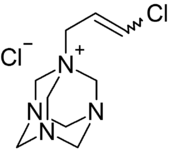 | |
| Names | |
|---|---|
| IUPAC name 1-(3-Chloroallyl)-3,5,7-triaza-1-azoniaadamantane chloride | |
Other names
| |
| Identifiers | |
| |
3D model (JSmol) | |
| ChemSpider | |
| ECHA InfoCard | 100.102.448 |
PubChem CID | |
| UNII |
|
CompTox Dashboard (EPA) | |
InChI
| |
SMILES
| |
| Properties | |
Chemical formula | C9H16Cl2N4 |
| Molar mass | 251.16 g·mol−1 |
| Hazards | |
| Safety data sheet | Sigma Aldrich[1] |
| GHS pictograms |     |
GHS hazard statements | H228, H302, H315, H317, H361, H411[1] |
GHS precautionary statements | P210, P273, P280[1] |
Except where otherwise noted, data are given for materials in their standard state (at 25 °C [77 °F], 100 kPa). | |
Quaternium-15 (systematic name: hexamethylenetetramine chloroallyl chloride) is a quaternary ammonium salt used as a surfactant and preservative in many cosmetics and industrial substances. It acts as an antimicrobial agent because it acts as a formaldehyde releaser,[2][3] though doing so can also cause contact dermatitis, a symptom of an allergic reaction, especially in those with sensitive skin.
It can be found under a variety of names, most commonly those of the Dow Chemical Company: Dowicil 200 (cis isomer only), Dowicil 75 and Dowicil 100 (both a mix of cis and trans isomers).
Synthesis
Quaternium-15 can be prepared by reacting hexamethylenetetramine with 1,3-dichloropropene to produce the product as a mixture of cis and trans isomers.
Applications
The isolated cis-compound is used primarily in cosmetic applications, with a maximum permitted concentration in the EU of 0.2%. The mixed product (cis- and trans-) is used in a wider range of formulations such as: emulsifiable metal-cutting fluids; latex and emulsion paints; liquid floor polishes and floor waxes; glues and adhesives.
Safety concerns
Quaternium-15 along with formaldehyde has been banned in the EU since 2017 and a bill is under consideration in the US.[4][5]
Allergic reaction
Quaternium-15 is an allergen, and can cause contact dermatitis in susceptible individuals.[6] Many of those with an allergy to quaternium-15 are also allergic to formaldehyde. At low pHs it would be expected to release significant amounts of formaldehyde due to acid hydrolysis via the Delepine reaction.
Allergic sensitivity to quaternium-15 can be detected using a patch test.[7] It is the single most often found cause of allergic contact dermatitis of the hands (16.5% in 959 cases).[8] In 2005–06, it was the fourth-most-prevalent allergen in patch tests (10.3%).[9]
Cancer
Some consumer cosmetics contain quaternium-15 for its antimicrobial properties.[2] The American Cancer Society states that although quaternium-15 releases formaldehyde, a known carcinogen in laboratory test animals at relatively high doses, because the amount of formaldehyde released from these products is low, it is unclear that avoiding quaternium-15 in cosmetics provides any health benefits.[10] Even so, Johnson & Johnson announced plans to phase out its use of quaternium-15 in cosmetic products by 2015 in response to consumer pressure.[11][12]
See also
References
- ^ a b c Sigma-Aldrich Co., 1-(cis-3-Chloroallyl)-3,5,7-triaza-1-azoniaadamantane chloride. Retrieved on 2014-10-07.
- ^ a b de Groot, Anton C.; White, Ian R.; Flyvholm, Mari-Ann; Lensen, Gerda; Coenraads, Pieter-Jan (2010). "Formaldehyde-releasers in cosmetics: relationship to formaldehyde contact allergy". Contact Dermatitis. 62 (1): 2–17. doi:10.1111/j.1600-0536.2009.01615.x.
- ^ De Groot, Anton; Geier, Johannes; Flyvholm, Mari-Ann; Lensen, Gerda; Coenraads, Pieter-Jan (22 June 2010). "Formaldehyde-releasers: Relationship to formaldehyde contact allergy, Part 2: Metalworking fluids and remainder". Contact Dermatitis: no–no. doi:10.1111/j.1600-0536.2010.01715.x.
- ^ "European Commission notifies bans, restrictions on CMRS in cosmetics". Retrieved 2 December 2019.
- ^ "The cosmetics industry has avoided strict regulation for over a century. Now rising health concerns has FDA inquiring". Retrieved 2 December 2019.
- ^ Cahill, J; Nixon, R (Nov 2005). "Allergic contact dermatitis to quaternium 15 in a moisturizing lotion". Australasia J Dermatol. 46 (4): 284–5. doi:10.1111/j.1440-0960.2005.00210.x. PMID 16197434.
- ^ New Zealand Dermatological Society. "Quaternium-15 contact allergy". DermNet NZ. Retrieved 2007-05-31.
- ^ Warshaw, E.; et al. (2007). "Contact dermatitis of the hands: Cross-sectional analyses of North American Contact Dermatitis Group Data, 1994–2004". Journal of the American Academy of Dermatology. 57 (2): 301–314. doi:10.1016/j.jaad.2007.04.016. PMID 17553593.
- ^ Zug, KA; Warshaw, EM; Fowler, JF Jr; Maibach, HI; Belsito, DL; Pratt, MD; Sasseville, D; Storrs, FJ; Taylor, JS; Mathias, CG; Deleo, VA; Rietschel, RL; Marks, J (2009). "Patch-test results of the North American Contact Dermatitis Group 2005–2006". Dermatitis. 20 (3): 149–60. doi:10.2310/6620.2009.08097. PMID 19470301.
- ^ "Formaldehyde". American Cancer Society. Retrieved 3 March 2016.
- ^ "Johnson & Johnson to phase out potentially harmful chemicals by 2015". CBS News. Retrieved 3 March 2016.
- ^ Thomas, Katie. "The 'No More Tears' Shampoo, Now With No Formaldehyde". The New York Times. Retrieved 3 March 2016.
External links
- Record in the Household Products Database of NLM
- Occupational Hazards - Quaternium-15